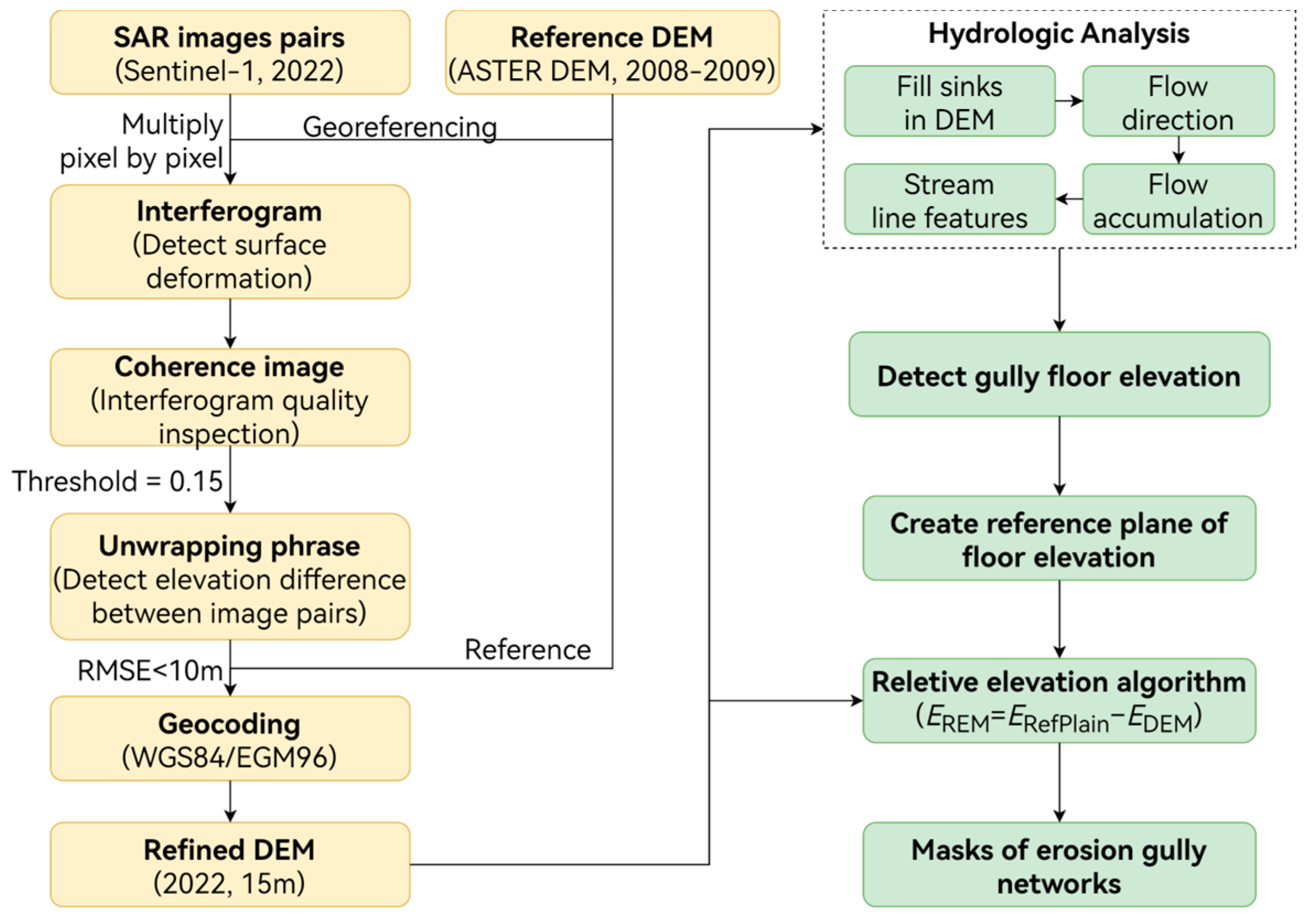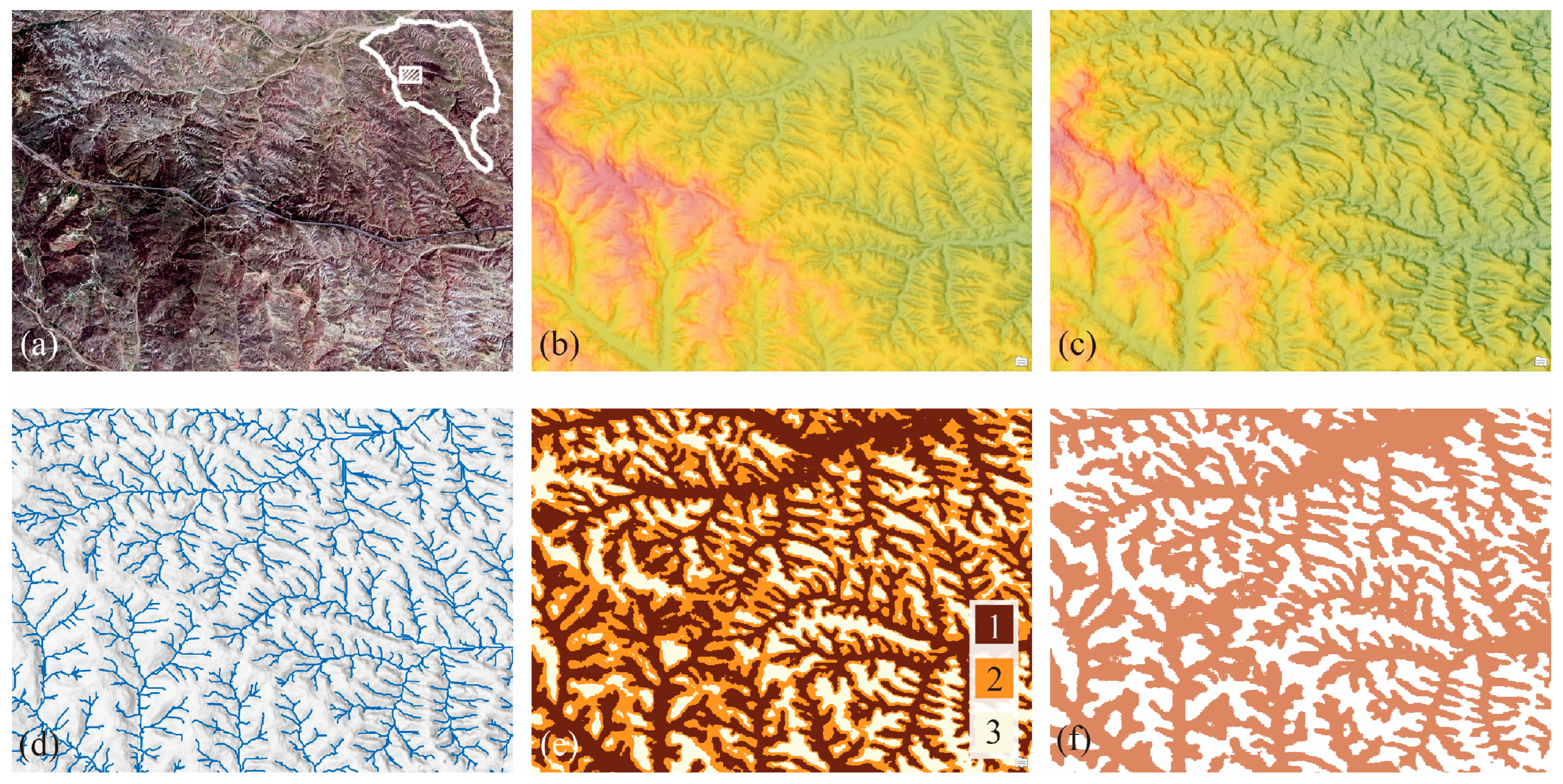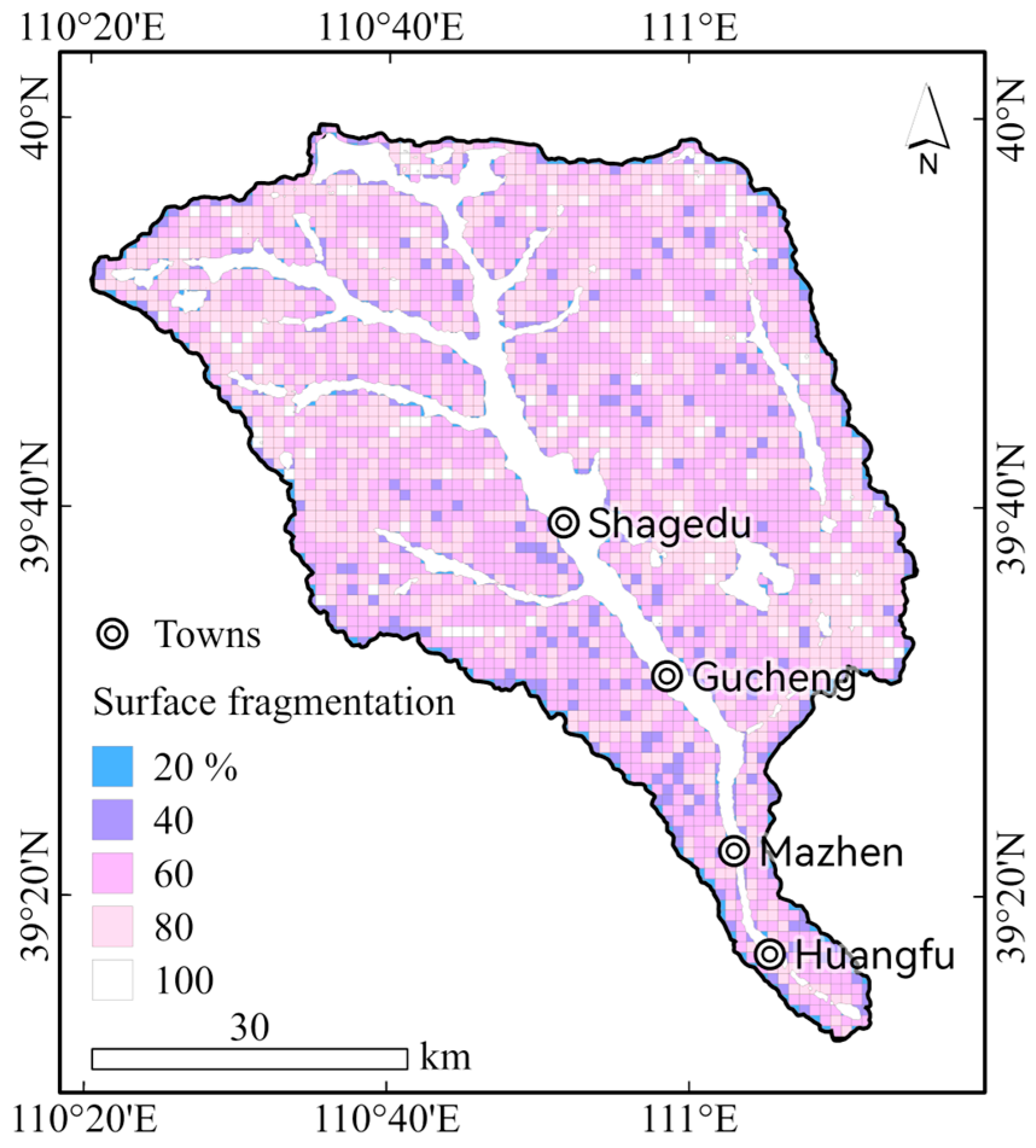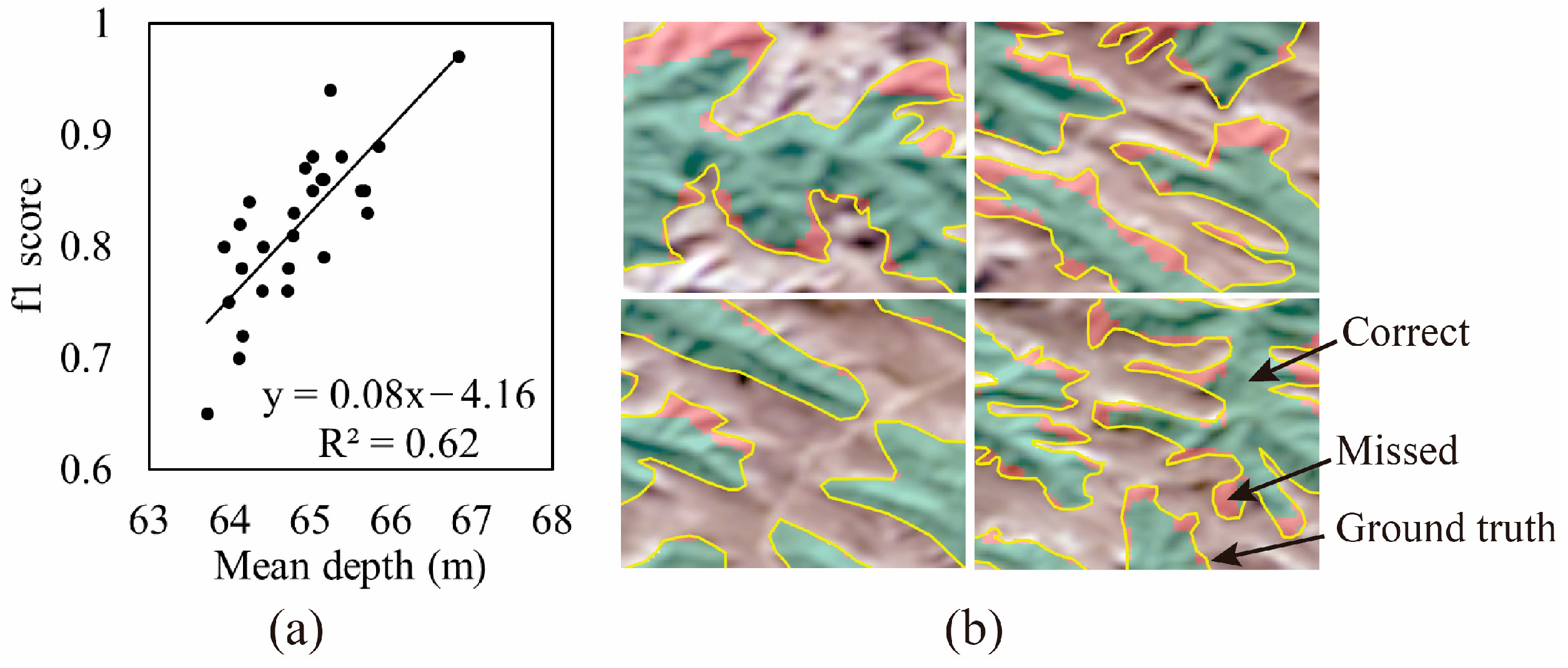Erosion Gully Networks Extraction Based on InSAR Refined Digital Elevation Model and Relative Elevation Algorithm—A Case Study in Huangfuchuan Basin, Northern Loess Plateau, China
Abstract
1. Introduction
2. Materials and Data
2.1. Study Area
2.2. Data
2.2.1. SAR Data
2.2.2. Auxiliary Data
3. Methods
3.1. DEM Reconstruction Using SAR Data
3.1.1. Retrieving Interferogram
3.1.2. Calculating Coherence Image
3.1.3. Unwrapping Phase
3.1.4. Geocoding Unwrapped Phase
3.2. Gullies Extraction
3.2.1. Detecting Floor Elevation of Erosion Gullies
3.2.2. Creating a Reference Plane
3.2.3. Extracting Mask of Erosion Gullies Using REA
3.3. Validation
4. Results
4.1. Extraction of Erosion Gullies
4.2. Characteristics of Extracted Erosion Gullies
4.3. Validation of the Proposed Extraction Method
5. Discussion
6. Conclusions
Author Contributions
Funding
Data Availability Statement
Conflicts of Interest
Appendix A
| Item | Value |
|---|---|
| Normal baseline (m) | 116.670 |
| Critical baseline min-max | −6406.247~6406.247 |
| Range shift (pixels) | −30.707 |
| Azimuth shift (pixels) | −1.836 |
| Slant range distance (m) | 878,897.093 |
| Absolute time baseline (days) | 24 |
| Doppler centroid diff. (Hz) | −21.058 |
| Critical min–max (Hz) | −486.486~486.486 |
| 2 PI ambiguity height (InSAR) (m) | 132.647 |
| 2 PI ambiguity displacement (DInSAR) (m) | 0.028 |
| 1 pixel shift ambiguity height (stereo radargrammetry) (m) | 11,142.344 |
| 1 Pixel Shift ambiguity displacement (amplitude tracking) (m) | 2.330 |
| Master incidence angle | 39.414 |
| Absolute incidence angle difference | 0.007 |


References
- Zhang, C.; Wang, C.; Long, Y.; Pang, G.; Shen, H.; Wang, L.; Yang, Q. Comparative Analysis of Gully Morphology Extraction Suitability Using Unmanned Aerial Vehicle and Google Earth Imagery. Remote Sens. 2023, 15, 4302. [Google Scholar] [CrossRef]
- Wilkinson, S.N.; Kinsey-Henderson, A.E.; Hawdon, A.A.; Hairsine, P.B.; Bartley, R.; Baker, B. Grazing Impacts on Gully Dynamics Indicate Approaches for Gully Erosion Control in Northeast Australia. Earth Surf. Process Landf. 2018, 43, 1711–1725. [Google Scholar] [CrossRef]
- Ding, H.; Liu, K.; Chen, X.; Xiong, L.; Tang, G.; Qiu, F.; Strobl, J. Optimized Segmentation Based on Theweighted Aggregation Method for Loess Bank Gully Mapping. Remote Sens. 2020, 12, 793. [Google Scholar] [CrossRef]
- Sun, L.; Liu, Y.F.; Wang, X.; Liu, Y.; Wu, G.L. Soil Nutrient Loss by Gully Erosion on Sloping Alpine Steppe in the Northern Qinghai-Tibetan Plateau. Catena 2022, 208, 105763. [Google Scholar] [CrossRef]
- Vanmaercke, M.; Poesen, J.; Van Mele, B.; Demuzere, M.; Bruynseels, A.; Golosov, V.; Bezerra, J.F.R.; Bolysov, S.; Dvinskih, A.; Frankl, A.; et al. How Fast Do Gully Headcuts Retreat? Earth Sci. Rev. 2016, 154, 336–355. [Google Scholar] [CrossRef]
- Vanmaercke, M.; Panagos, P.; Vanwalleghem, T.; Hayas, A.; Foerster, S.; Borrelli, P.; Rossi, M.; Torri, D.; Casali, J.; Borselli, L.; et al. Measuring, Modelling and Managing Gully Erosion at Large Scales: A State of the Art. Earth Sci. Rev. 2021, 218, 103637. [Google Scholar] [CrossRef]
- Castillo, C.; Gómez, J.A. A Century of Gully Erosion Research: Urgency, Complexity and Study Approaches. Earth Sci. Rev. 2016, 160, 300–319. [Google Scholar] [CrossRef]
- Zhao, J.; Vanmaercke, M.; Chen, L.; Govers, G. Vegetation Cover and Topography Rather than Human Disturbance Control Gully Density and Sediment Production on the Chinese Loess Plateau. Geomorphology 2016, 274, 92–105. [Google Scholar] [CrossRef]
- Goodwin, N.R.; Armston, J.D.; Muir, J.; Stiller, I. Monitoring Gully Change: A Comparison of Airborne and Terrestrial Laser Scanning Using a Case Study from Aratula, Queensland. Geomorphology 2017, 282, 195–208. [Google Scholar] [CrossRef]
- Perroy, R.L.; Bookhagen, B.; Asner, G.P.; Chadwick, O.A. Comparison of Gully Erosion Estimates Using Airborne and Ground-Based LiDAR on Santa Cruz Island, California. Geomorphology 2010, 118, 288–300. [Google Scholar] [CrossRef]
- Liu, B.; Zhang, B.; Feng, H.; Wu, S.; Yang, J.; Zou, Y.; Siddique, K.H.M. Ephemeral Gully Recognition and Accuracy Evaluation Using Deep Learning in the Hilly and Gully Region of the Loess Plateau in China. Int. Soil. Water Conserv. Res. 2022, 10, 371–381. [Google Scholar] [CrossRef]
- Chen, W.; Lei, X.; Chakrabortty, R.; Chandra Pal, S.; Sahana, M.; Janizadeh, S. Evaluation of Different Boosting Ensemble Machine Learning Models and Novel Deep Learning and Boosting Framework for Head-Cut Gully Erosion Susceptibility. J. Environ. Manag. 2021, 284, 112015. [Google Scholar] [CrossRef] [PubMed]
- Xue, Y.; Qin, C.; Wu, B.; Zhang, G.; Fu, X.; Ma, H.; Li, D.; Wang, B. Simulation of Runoff Process Based on the 3-D River Network. J. Hydrol. 2023, 626, 130192. [Google Scholar] [CrossRef]
- Lv, G.N.; Qian, Y.D.; Chen, Z.M. Study of Automated Extraction of Shoulder Line of Valley from Grid Digital Elevation Data. Sci. Geogr. Sin. 1998, 18, 567–573. [Google Scholar]
- Yan, S.; Tang, G.; Li, F.; Zhang, L. Snake Model for the Extraction of Loess Shoulder-Line from DEMs. J. Mt. Sci. 2014, 11, 1552–1559. [Google Scholar] [CrossRef]
- Yan, S.; Tang, G.; Li, F.; Dong, Y. An Edge Detection Based Method for Extraction of Loess Shoulder-Line from Grid DEM. Geomat. Inf. Sci. Wuhan Univ. 2011, 36, 363–367. [Google Scholar]
- Jiang, S.; Tang, G.; Liu, K. A New Extraction Method of Loess Shoulder-Line Based on Marr-Hildreth Operator and Terrain Mask. PLoS ONE 2015, 10, e0123804. [Google Scholar] [CrossRef]
- Yang, X.; Na, J.; Tang, G.; Wang, T.; Zhu, A. Bank Gully Extraction from DEMs Utilizing the Geomorphologic Features of a Loess Hilly Area in China. Front. Earth Sci. 2019, 13, 151–168. [Google Scholar] [CrossRef]
- Poesen, J.; Nachtergaele, J.; Verstraeten, G.; Valentin, C. Gully Erosion and Environmental Change: Importance and Research Needs. Catena 2003, 50, 91–133. [Google Scholar] [CrossRef]
- Qin, F.; Han, Z. Landform Evolution Modeling of a Small Catchment in the Loess Plateau. In Proceedings of the 2010 18th International Conference on Geoinformatics, Beijing, China, 18–20 June 2010; pp. 1–8. [Google Scholar]
- Zhang, W.; Zhu, W.; Tian, X.; Zhang, Q.; Zhao, C.; Niu, Y.; Wang, C. Improved DEM Reconstruction Method Based on Multibaseline InSAR. IEEE Geosci. Remote Sens. Lett. 2022, 19, 4011505. [Google Scholar] [CrossRef]
- Liu, S.; Tang, H.; Feng, Y.; Chen, Y.; Lei, Z.; Wang, J.; Tong, X. A Comparative Study of DEM Reconstruction Using the Single-Baseline and Multibaseline InSAR Techniques. IEEE J. Sel. Top. Appl. Earth Obs. Remote Sens. 2021, 14, 8512–8521. [Google Scholar] [CrossRef]
- Braun, A. Retrieval of Digital Elevation Models from Sentinel-1 Radar Data—Open Applications, Techniques, and Limitations. Open Geosci. 2021, 13, 532–569. [Google Scholar] [CrossRef]
- Zhou, X.; Chang, N.-B.; Li, S. Applications of SAR Interferometry in Earth and Environmental Science Research. Sensors 2009, 9, 1876–1912. [Google Scholar] [CrossRef]
- Hu, J.; Li, Z.W.; Ding, X.L.; Zhu, J.J.; Zhang, L.; Sun, Q. Resolving Three-Dimensional Surface Displacements from InSAR Measurements: A Review. Earth Sci. Rev. 2014, 133, 1–17. [Google Scholar] [CrossRef]
- Berardino, P.; Fornaro, G.; Lanari, R.; Sansosti, E. A New Algorithm for Surface Deformation Monitoring Based on Small Baseline Differential SAR Interferograms. IEEE Trans. Geosci. Remote Sens. 2002, 40, 2375–2383. [Google Scholar] [CrossRef]
- Zhao, C.; Zhang, Q.; He, Y.; Peng, J.; Yang, C.; Kang, Y. Small-Scale Loess Landslide Monitoring with Small Baseline Subsets Interferometric Synthetic Aperture Radar Technique—Case Study of Xingyuan Landslide, Shaanxi, China. J. Appl. Remote Sens. 2016, 10, 026030. [Google Scholar] [CrossRef]
- Olson, P.L.; Legg, N.T.; Abbe, T.B.; Reinhart, M.A.; Radloff, J.K. A Methodology for Delineating Planning-Level Channel Migration Zones; Washington State Department of Ecology Publication: Washington, DC, USA, 2014.
- Fu, B. Soil Erosion and Its Control in the Loess Plateau of China. Soil. Use Manag. 1989, 5, 76–82. [Google Scholar] [CrossRef]
- Zhang, Y.; He, Y.; Song, J. Effects of Climate Change and Land Use on Runoff in the Huangfuchuan Basin, China. J. Hydrol. 2023, 626, 130195. [Google Scholar] [CrossRef]
- Sui, J.; He, Y.; Karney, B.W. Flow and High Sediment Yield from the Huangfuchuan Watershed. Int. J. Environ. Sci. Technol. 2008, 5, 149–160. [Google Scholar] [CrossRef]
- Dang, S.; Liu, X.; Yin, H.; Guo, X. Prediction of Sediment Yield in the Middle Reaches of the Yellow River Basin Under Extreme Precipitation. Front. Earth Sci. 2020, 8, 542686. [Google Scholar] [CrossRef]
- Shi, H.; Li, T.; Wang, K.; Zhang, A.; Wang, G.; Fu, X. Physically Based Simulation of the Streamflow Decrease Caused by Sediment-trapping Dams in the Middle Yellow River. Hydrol. Process 2016, 30, 783–794. [Google Scholar] [CrossRef]
- Ma, W.; Tang, P.; Zhou, X.; Li, G.; Zhu, W. Study on the Failure Mechanism of a Modified Hydrophilic Polyurethane Material Pisha Sandstone System under Dry–Wet Cycles. Polymers 2022, 14, 4837. [Google Scholar] [CrossRef]
- Li, C.; Song, L.; Cao, Y.; Zhao, S.; Liu, H.; Yang, C.; Cheng, H.; Jia, D. Investigating the Mechanical Property and Enhanced Mechanism of Modified Pisha Sandstone Geopolymer via Ion Exchange Solidification. Gels 2022, 8, 300. [Google Scholar] [CrossRef]
- Zhang, X.; Li, X.; Lu, Y.; Lu, Y.; Fan, W. A Study on the Collapse Characteristics of Loess Based on Energy Spectrum Superposition Method. Heliyon 2023, 9, e18643. [Google Scholar] [CrossRef]
- Chen, H.; Jiang, Y.; Gao, Y.; Yuan, X. Structural Characteristics and Its Influencing Factors of Typical Loess. Bull. Eng. Geol. Environ. 2019, 78, 4893–4905. [Google Scholar] [CrossRef]
- Liang, Z.; Wu, Z.; Yao, W.; Noori, M.; Yang, C.; Xiao, P.; Leng, Y.; Deng, L. Pisha Sandstone: Causes, Processes and Erosion Options for Its Control and Prospects. Int. Soil. Water Conserv. Res. 2019, 7, 1–8. [Google Scholar] [CrossRef]
- Zhang, K.; Xu, M.; Wang, Z. Study on Reforestation with Seabuckthorn in the Pisha Sandstone Area. J. Hydro-Environ. Res. 2009, 3, 77–84. [Google Scholar] [CrossRef]
- Alessandro, F.; Andrea, M.-G.; Claudio, P.; Fabio, R.; Didier, M. Part A: Interferometric SAR Image Processing and Interpretation. In InSAR Principles: Guidelines for SAR Interferometry Processing and Interpretation; Karen, F., Ed.; ESA Publications: Noordwijk, The Netherlands, 2007. [Google Scholar]
- National Aeronautics and Space Administration (NASA) Sentinel-1—Alaska Satellite Facility. Available online: https://asf.alaska.edu/datasets/daac/sentinel-1/ (accessed on 10 December 2023).
- NASA/METI/AIST/Japan Space Systems and U.S./Japan ASTER Science Team. ASTER Global Digital Elevation Model V003. Available online: https://lpdaac.usgs.gov/products/astgtmv003/ (accessed on 10 December 2023).
- Michael, A.; Robert, C. ASTER GDEM V3 (ASTER Global DEM) User Guide. Available online: https://lpdaac.usgs.gov/documents/434/ASTGTM_User_Guide_V3.pdf (accessed on 10 December 2023).
- Liu, X.; Ran, M.; Xia, H.; Deng, M. Evaluating Vertical Accuracies of Open-Source Digital Elevation Models over Multiple Sites in China Using GPS Control Points. Remote Sens. 2022, 14, 2000. [Google Scholar] [CrossRef]
- Gesch, D.; Oimoen, M.; Danielson, J.; Meyer, D. Validation of the ASTER Global Digital Elevation Model Version 3 over the Conterminous United States. Int. Arch. Photogramm. Remote Sens. Spat. Inf. Sci. 2016, XLI-B4, 143–148. [Google Scholar] [CrossRef]
- Sun, L.; Liu, P.; Zhang, W.; Hou, S.; Sun, H. Precision Comparing and Analyzing Between ASTER DEM and 1:50000 National Digital Elevation Data. Geomat. Spat. Inf. Technol. 2013, 36, 1–6. [Google Scholar]
- Liu, H.; Zhou, B.; Bai, Z.; Zhao, W.; Zhu, M.; Zheng, K.; Yang, S.; Li, G. Applicability Assessment of Multi-Source DEM-Assisted InSAR Deformation Monitoring Considering Two Topographical Features. Land 2023, 12, 1284. [Google Scholar] [CrossRef]
- Li, H.; Zhao, J.; Yan, B.; Yue, L.; Wang, L. Global DEMs Vary from One to Another: An Evaluation of Newly Released Copernicus, NASA and AW3D30 DEM on Selected Terrains of China Using ICESat-2 Altimetry Data. Int. J. Digit. Earth 2022, 15, 1149–1168. [Google Scholar] [CrossRef]
- Vera, L.-T.; Philipp, J.; Henning, S.; Hanjo, K. Copernicus DEM Copernicus Digital Elevation Model Validation Report. Available online: https://spacedata.copernicus.eu/documents/20123/121239/GEO1988-CopernicusDEM-RP-001_ValidationReport_I3.0.pdf/ (accessed on 10 December 2023).
- Esri. Pansharpened Landsat. Available online: https://www.arcgis.com/home/item.html?id=a7412d0c33be4de698ad981c8ba471e6 (accessed on 10 December 2023).
- Zebker, H.A.; Goldstein, R.M. Topographic Mapping from Interferometric Synthetic Aperture Radar Observations. J. Geophys. Res. Solid. Earth 1986, 91, 4993–4999. [Google Scholar] [CrossRef]
- Uys, D. InSAR: An Introduction. Preview 2016, 2016, 43–48. [Google Scholar] [CrossRef]
- Hanssen, R.F. Radar Interferometry: Data Interpretation and Error Analysis; Kluwer Academic Publishers: Dordrecht, The Netherlands, 2001. [Google Scholar]
- Wang, T.; Liao, M.; Perissin, D. InSAR Coherence-Decomposition Analysis. IEEE Geosci. Remote Sens. Lett. 2010, 7, 156–160. [Google Scholar] [CrossRef]
- Zebker, H.A.; Lu, Y. Phase Unwrapping Algorithms for Radar Interferometry: Residue-Cut, Least-Squares, and Synthesis Algorithms. J. Opt. Soc. Am. A 1998, 15, 586. [Google Scholar] [CrossRef]
- Goldstein, R.M.; Werner, C.L. Radar Interferogram Filtering for Geophysical Applications. Geophys. Res. Lett. 1998, 25, 4035–4038. [Google Scholar] [CrossRef]
- Kervyn, F. Modelling Topography with SAR Interferometry: Illustrations of a Favourable and Less Favourable Environment. Comput. Geosci. 2001, 27, 1039–1050. [Google Scholar] [CrossRef]
- Qin, C.; Zhu, A.-X.; Pei, T.; Li, B.; Zhou, C.; Yang, L. An Adaptive Approach to Selecting a Flow-partition Exponent for a Multiple-flow-direction Algorithm. Int. J. Geogr. Inf. Sci. 2007, 21, 443–458. [Google Scholar] [CrossRef]
- Zhang, H.; Loáiciga, H.A.; Feng, L.; He, J.; Du, Q. Setting the Flow Accumulation Threshold Based on Environmental and Morphologic Features to Extract River Networks from Digital Elevation Models. ISPRS Int. J. Geoinf. 2021, 10, 186. [Google Scholar] [CrossRef]
- Hutchinson, M.F.; Xu, T.; Stein, J. Recent Progress in the ANUDEM Elevation Gridding Procedure. 2011. Available online: https://www.researchgate.net/publication/268405980_Recent_Progress_in_the_ANUDEM_Elevation_Gridding_Procedure (accessed on 10 December 2023).
- Yang, Q.; McVicar, T.R.; Van Niel, T.G.; Hutchinson, M.F.; Li, L.; Zhang, X. Improving a Digital Elevation Model by Reducing Source Data Errors and Optimising Interpolation Algorithm Parameters: An Example in the Loess Plateau, China. Int. J. Appl. Earth Obs. Geoinf. 2007, 9, 235–246. [Google Scholar] [CrossRef]
- Jenks, G.F.; Caspall, F.C. Error on Choroplethic Maps: Definition, Measurement, Reduction. Ann. Assoc. Am. Geogr. 1971, 61, 217–244. [Google Scholar] [CrossRef]
- Jenks, G.F. The Data Model Concept in Statistical Mapping. Int. Yearb. Cartogr. 1967, 7, 186–190. [Google Scholar]
- Osaragi, T. Classification Methods for Spatial Data Representation. In Osaragi, Toshihiro (2002) Classification Methods for Spatial Data Representation; Working paper. CASA Working Papers (40); Centre for Advanced Spatial Analysis (UCL): London, UK, 2008. [Google Scholar]
- Hou, C.; Xie, Y.; Zhang, Z. An Improved Convolutional Neural Network Based Indoor Localization by Using Jenks Natural Breaks Algorithm. China Commun. 2022, 19, 291–301. [Google Scholar] [CrossRef]
- Anchang, J.Y.; Ananga, E.O.; Pu, R. An Efficient Unsupervised Index Based Approach for Mapping Urban Vegetation from IKONOS Imagery. Int. J. Appl. Earth Obs. Geoinf. 2016, 50, 211–220. [Google Scholar] [CrossRef]
- Su, H.; Ma, X.; Li, M. An Improved Spatio-Temporal Clustering Method for Extracting Fire Footprints Based on MCD64A1 in the Daxing’anling Area of North-Eastern China. Int. J. Wildland Fire 2023, 32, 679–693. [Google Scholar] [CrossRef]
- Dai, W.; Yang, X.; Na, J.; Li, J.; Brus, D.; Xiong, L.; Tang, G.; Huang, X. Effects of DEM Resolution on the Accuracy of Gully Maps in Loess Hilly Areas. Catena 2019, 177, 114–125. [Google Scholar] [CrossRef]
- Thompson, J.A.; Bell, J.C.; Butler, C.A. Digital Elevation Model Resolution: Effects on Terrain Attribute Calculation and Quantitative Soil-Landscape Modeling. Geoderma 2001, 100, 67–89. [Google Scholar] [CrossRef]
- Salekin, S.; Lad, P.; Morgenroth, J.; Dickinson, Y.; Meason, D.F. Uncertainty in Primary and Secondary Topographic Attributes Caused by Digital Elevation Model Spatial Resolution. Catena 2023, 231, 107320. [Google Scholar] [CrossRef]
- Maerker, M.; Quénéhervé, G.; Bachofer, F.; Mori, S. A Simple DEM Assessment Procedure for Gully System Analysis in the Lake Manyara Area, Northern Tanzania. Nat. Hazards 2015, 79, 235–253. [Google Scholar] [CrossRef]
- Ghosh, S.; Guchhait, S.K.; Illahi, R.A.; Bera, S.; Roy, S. Geomorphic Character and Dynamics of Gully Morphology, Erosion and Management in Laterite Terrain: Few Observations from Dwarka—Brahmani Interfluve, Eastern India. Geol. Ecol. Landsc. 2022, 6, 188–216. [Google Scholar] [CrossRef]
- Wang, R.; Li, P.; Li, Z.; Yu, K.; Han, J.; Zhu, Y.; Su, Y. Effects of Gully Head Height and Soil Texture on Gully Headcut Erosion in the Loess Plateau of China. Catena 2021, 207, 105674. [Google Scholar] [CrossRef]











| ID | Acquired Time | Path | Frame | Beam Mode | Polarization | Baseline | |
|---|---|---|---|---|---|---|---|
| Perpendicular (m) | Temporal (d) | ||||||
| 1 | 24 November 2022 10:30:34 | 113 | 126 | IW | VV + VH | 127 | 24 |
| 2 | 18 November 2022 10:30:33 | 113 | 126 | IW | VV + VH | ||
Disclaimer/Publisher’s Note: The statements, opinions and data contained in all publications are solely those of the individual author(s) and contributor(s) and not of MDPI and/or the editor(s). MDPI and/or the editor(s) disclaim responsibility for any injury to people or property resulting from any ideas, methods, instructions or products referred to in the content. |
© 2024 by the authors. Licensee MDPI, Basel, Switzerland. This article is an open access article distributed under the terms and conditions of the Creative Commons Attribution (CC BY) license (https://creativecommons.org/licenses/by/4.0/).
Share and Cite
Lu, P.; Zhang, B.; Wang, C.; Liu, M.; Wang, X. Erosion Gully Networks Extraction Based on InSAR Refined Digital Elevation Model and Relative Elevation Algorithm—A Case Study in Huangfuchuan Basin, Northern Loess Plateau, China. Remote Sens. 2024, 16, 921. https://doi.org/10.3390/rs16050921
Lu P, Zhang B, Wang C, Liu M, Wang X. Erosion Gully Networks Extraction Based on InSAR Refined Digital Elevation Model and Relative Elevation Algorithm—A Case Study in Huangfuchuan Basin, Northern Loess Plateau, China. Remote Sensing. 2024; 16(5):921. https://doi.org/10.3390/rs16050921
Chicago/Turabian StyleLu, Pingda, Bin Zhang, Chenfeng Wang, Mengyun Liu, and Xiaoping Wang. 2024. "Erosion Gully Networks Extraction Based on InSAR Refined Digital Elevation Model and Relative Elevation Algorithm—A Case Study in Huangfuchuan Basin, Northern Loess Plateau, China" Remote Sensing 16, no. 5: 921. https://doi.org/10.3390/rs16050921
APA StyleLu, P., Zhang, B., Wang, C., Liu, M., & Wang, X. (2024). Erosion Gully Networks Extraction Based on InSAR Refined Digital Elevation Model and Relative Elevation Algorithm—A Case Study in Huangfuchuan Basin, Northern Loess Plateau, China. Remote Sensing, 16(5), 921. https://doi.org/10.3390/rs16050921









